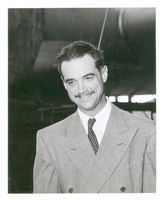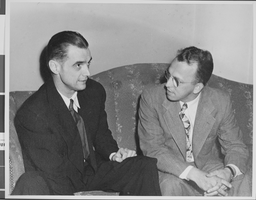Search the Special Collections and Archives Portal
Search Results

Photograph of Howard Hughes, Washington, D.C., August 1947
Date
Archival Collection
Description
Image
Geraldine Kirk-Hughes oral history interview
Identifier
Abstract
Oral history interview with Geraldine Kirk-Hughes conducted by Larry Sampson on November 28, 2014 for the African Americans in Las Vegas: a Collaborative Oral History Project. In this interview Kirk-Hughes relates her birth and upbringing in Simmersport, Louisiana, becoming a teen mother, earning a GED and earning her first college degree before marrying and moving to Greece and Dubai. She then explains how she returned to the United States to earn her masters degree before moving to Las Vegas, Nevada in 1978. She discusses her second marriage, her decision to attend law school, and her decision to go into private practice instead of working for a law firm. She talks about cases she worked on, people in the community she knew, and the effects of discrimination on her work and career. She ends by talking about her third marriage and sharing thoughts on how the Las Vegas African American community has lost some of the cohesiveness and unity of earlier decades.
Archival Collection
Various Hughes Electronics/Hughes Aircraft Company organizational charts, 1984 to 1995
Level of Description
Archival Collection
Pagination
- Previous page ‹‹
- Page 6
Archival Component
Howard Hughes and Earl Martyn inside of the HK-1 Hughes Flying Boat, 1947
Level of Description
Archival Collection
Pagination
- Previous page ‹‹
- Page 6
Archival Component
Letter from Howard Hughes to the general manager of Hughes Aircraft Company, 1949
Level of Description
Archival Collection
Pagination
- Previous page ‹‹
- Page 6
Archival Component
Articles and cartoon related to Hughes Aircraft Comapnay and/or Howard Hughes, 1985-1990
Level of Description
Archival Collection
Pagination
- Previous page ‹‹
- Page 6
Archival Component
Hughes XF-11 photographs, 1946-1947
Level of Description
Scope and Contents
Materials contain photographs of the Hughes XF-11 prototype military reconnaissance aircraft. Howard Hughes piloted the two XF-11 prototypes built: in July 1946, Hughes crashed the first XF-11 in Beverly Hills, California; in April 1947, Hughes successfully flew the second prototype at high speeds and at high altitudes. However, the United States Air Force abandoned the controversial project, and in August of 1947, Hughes was called to testify before the Truman Committee in the U.S. Senate about the failures of the program.
Archival Collection
Pagination
- Previous page ‹‹
- Page 6
Archival Component

Photograph of Howard Hughes and an unidentified man, circa 1944
Date
Archival Collection
Description
Image
Howard Hughes in the cockpit of the Hughes H-1 Racer being interviewed, 1937 January 19
Level of Description
Archival Collection
Pagination
- Previous page ‹‹
- Page 6
Archival Component
People associated with Howard Hughes, 1947-1976
Level of Description
Scope and Contents
The people associated with Howard Hughes series dates from 1947-1976 and is composed entirely of reference files of newspaper clippings that document Hughes employees, business associates, competitors, and relatives, as well as politicians and government officials that were of interest to Hughes.
Archival Collection
Pagination
- Previous page ‹‹
- Page 6
Archival Component
